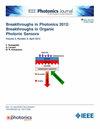基于多重先验深度展开网络的单像素智能识别
IF 2.1
4区 工程技术
Q3 ENGINEERING, ELECTRICAL & ELECTRONIC
引用次数: 0
摘要
单像素成像(SPI)是一种基于压缩传感理论的成像技术,由于其成像速度相对较慢,在实时成像和高分辨率图像方面受到限制。近年来,基于深度学习的深度展开网络压缩传感重建算法已被证明是更快、更高质量图像重建的有效解决方案。然而,现有的深度展开网络主要依赖于单一的先验信息,可能会忽略图像的其他内在结构。因此,我们在本文中提出了一种融合多种先验信息的深度展开网络(MPDU-Net)。为了有效融合多种先验信息,我们在深度重构子网络中提出了三种不同的融合策略。无偏卷积层用于模拟采样重建过程,以实现联合重建,有效去除块状伪影。采样矩阵作为可学习参数被输入深度重构子网络,以实现采样重构的联合优化。仿真和实际实验结果表明,所提出的网络优于现有的基于深度展开网络的压缩传感重建算法。本文章由计算机程序翻译,如有差异,请以英文原文为准。
Single Pixel Imaging Based on Multiple Prior Deep Unfolding Network
Single-pixel imaging (SPI), an imaging technique based on the theory of compressed sensing, is limited in real-time imaging and high-resolution images due to its relatively slow imaging speed. In recent years, deep unfolding network compressed sensing reconstruction algorithms based on deep learning have proven to be an effective solution for faster and higher quality image reconstruction. However, existing deep unfolding networks mainly rely on a single piece of a priori information and may ignore other intrinsic structures of the image. Therefore, in this paper, we propose a deep unfolding network (MPDU-Net) that incorporates multiple prior information. To effectively fuse multiple prior information, we propose three different fusion strategies in the deep reconstruction sub-network. An unbiased convolutional layer is used to simulate the sampling reconstruction process to achieve joint reconstruction for effective removal of block artifacts. The sampling matrix is input into the deep reconstruction sub-network as a learnable parameter to achieve joint optimization of sampling reconstruction. Simulation and practical experimental results show that the proposed network outperforms existing compressed sensing reconstruction algorithms based on deep unfolding networks.
求助全文
通过发布文献求助,成功后即可免费获取论文全文。
去求助
来源期刊

IEEE Photonics Journal
ENGINEERING, ELECTRICAL & ELECTRONIC-OPTICS
CiteScore
4.50
自引率
8.30%
发文量
489
审稿时长
1.4 months
期刊介绍:
Breakthroughs in the generation of light and in its control and utilization have given rise to the field of Photonics, a rapidly expanding area of science and technology with major technological and economic impact. Photonics integrates quantum electronics and optics to accelerate progress in the generation of novel photon sources and in their utilization in emerging applications at the micro and nano scales spanning from the far-infrared/THz to the x-ray region of the electromagnetic spectrum. IEEE Photonics Journal is an online-only journal dedicated to the rapid disclosure of top-quality peer-reviewed research at the forefront of all areas of photonics. Contributions addressing issues ranging from fundamental understanding to emerging technologies and applications are within the scope of the Journal. The Journal includes topics in: Photon sources from far infrared to X-rays, Photonics materials and engineered photonic structures, Integrated optics and optoelectronic, Ultrafast, attosecond, high field and short wavelength photonics, Biophotonics, including DNA photonics, Nanophotonics, Magnetophotonics, Fundamentals of light propagation and interaction; nonlinear effects, Optical data storage, Fiber optics and optical communications devices, systems, and technologies, Micro Opto Electro Mechanical Systems (MOEMS), Microwave photonics, Optical Sensors.
 求助内容:
求助内容: 应助结果提醒方式:
应助结果提醒方式:


